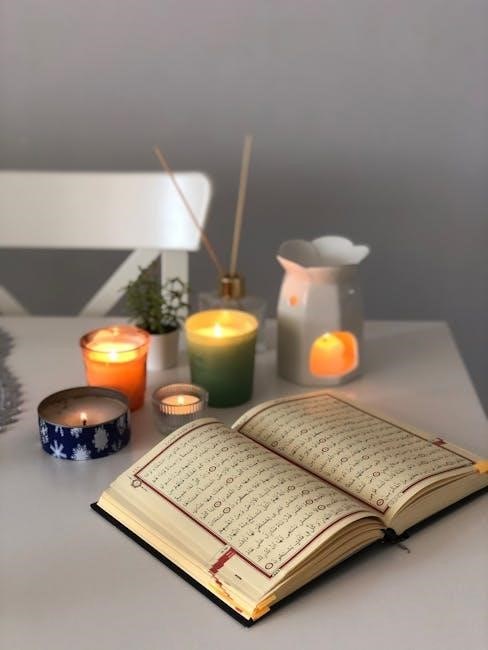A 20-minute guided meditation script offers a structured practice to deepen relaxation and awareness. It combines mindfulness, breathing techniques, and visualization to promote mental and physical calmness. Perfect for beginners, this duration balances effectiveness with accessibility, making it easy to incorporate into daily routines for lasting well-being.
1.1 What is a Guided Meditation Script?
A guided meditation script is a structured guide that leads individuals through a meditation practice, often including breathing techniques, visualization, and relaxation exercises. These scripts are typically written or narrated by experienced practitioners to help beginners or seasoned meditators focus their minds and achieve a calm, meditative state. A 20-minute guided meditation script is designed to provide a clear framework, ensuring a balanced and effective session. It often begins with deep breathing to settle the mind, followed by progressive relaxation or visualization to deepen the practice. The script serves as a roadmap, allowing participants to follow effortlessly without distractions, making meditation accessible and enjoyable for all levels of experience.
1.2 Why 20 Minutes is an Ideal Duration for Meditation
A 20-minute meditation session is considered optimal for achieving a deep state of relaxation and focus. This duration allows the mind to transition from a busy, distracted state to one of calm awareness, making it particularly effective for reducing stress and anxiety; According to various sources, 20 minutes is sufficient to induce physiological changes, such as lowering cortisol levels and slowing heart rate, while also being short enough to maintain engagement and prevent restlessness. This balanced timeframe makes it accessible for both newcomers and experienced practitioners, ensuring a meaningful yet manageable practice that can easily fit into a daily routine.

Benefits of 20-Minute Guided Meditation
A 20-minute guided meditation promotes relaxation, mental clarity, and emotional balance.
It reduces stress and anxiety, enhances focus, and improves sleep quality,
rejuvenating both mind and body for a refreshed, calm state of being.
2.1 Reducing Stress and Anxiety
A 20-minute guided meditation script is an effective tool for reducing stress and anxiety.
By focusing on deep breathing and progressive muscle relaxation, it helps calm the mind and body.
Visualization techniques guide the listener to imagine peaceful scenarios, distracting from stressful thoughts.
The structured format ensures a safe space for emotional release and relaxation.
Regular practice can lower cortisol levels, improve mood, and enhance overall mental well-being.
This practice fosters resilience, helping individuals manage daily challenges with greater ease and clarity.
2.2 Improving Focus and Concentration

A 20-minute guided meditation script enhances focus by training the mind to concentrate on specific sensations or visualizations.
Through mindfulness techniques, individuals learn to observe thoughts without distraction, improving mental clarity.
The structured practice helps quiet the mind, reducing mental chatter and increasing attention span.
Progressive relaxation and breathing exercises further calm the body, allowing the mind to stay present.
Regular practice strengthens cognitive abilities, making it easier to stay focused in daily activities.
This improved concentration can lead to greater productivity and mental performance in both personal and professional settings.
2.3 Enhancing Sleep Quality
A 20-minute guided meditation script can significantly improve sleep quality by promoting relaxation and reducing stress.
Through calming visualization and deep breathing, the body releases tension, preparing it for rest.
Mindfulness techniques help quiet the mind, reducing racing thoughts that often disrupt sleep.
Progressive relaxation scripts further ease muscle tension, creating a soothing atmosphere for slumber.
Regular practice can regulate sleep patterns, leading to deeper and more restorative sleep.
By addressing stress and anxiety, these meditations create a mental and physical environment conducive to falling asleep and staying asleep, enhancing overall sleep quality and morning refreshment.

Types of 20-Minute Guided Meditation Scripts
20-minute guided meditation scripts include mindfulness, relaxation, and guided imagery. These structured practices promote focus, calmness, and mental clarity, catering to diverse goals like stress relief or sleep improvement.
3.1 Mindfulness Meditation Scripts
Mindfulness meditation scripts focus on cultivating present-moment awareness. These 20-minute guided practices often begin with deep breathing to settle the mind and body. The script then gently directs attention to sensory experiences, such as the breath, body sensations, or sounds, encouraging non-judgmental observation. Participants are guided to notice thoughts without attachment, fostering a sense of calm and clarity. Many scripts incorporate a body scan or mindful movement to enhance relaxation and grounding. The goal is to help listeners develop greater self-awareness and reduce mental chatter, creating a lasting sense of peace and emotional balance in daily life.
3.2 Relaxation and Body Scan Scripts
Relaxation and body scan scripts are designed to melt away tension and promote deep relaxation; These 20-minute meditations typically start with calming breathing techniques to slow down the mind and body. The guide then leads listeners through a progressive scan of each body part, beginning at the toes and moving upward. This process encourages the release of physical and mental stress. Scripts often include soothing imagery, such as warmth or light flowing through the body, enhancing the sense of calm. By the end, participants feel refreshed and rejuvenated, with a heightened connection to their physical and emotional well-being.
3.3 Guided Imagery and Visualization Scripts
Guided imagery and visualization scripts immerse listeners in vivid mental landscapes to evoke emotional and physical responses. These 20-minute meditations transport participants to serene environments, such as beaches or forests, using descriptive language to engage the senses. The guide may lead them to visualize healing light or positive outcomes, fostering a sense of empowerment and calm. By combining imaginative scenarios with relaxation techniques, these scripts help reduce stress and enhance creativity. Regular practice can deepen self-awareness and improve overall well-being, making guided imagery a powerful tool for personal growth and emotional balance.

How to Create an Effective 20-Minute Meditation Script
Start with a soothing introduction, then guide listeners through relaxation techniques, focusing on breath, body awareness, or visualization. End with a gentle transition back to awareness.
4.1 Structuring the Script for Maximum Impact
Structuring a 20-minute guided meditation script involves a clear beginning, middle, and end. Start with a welcoming introduction and deep breathing to calm the mind. Next, guide the listener through progressive relaxation or visualization techniques, ensuring each segment flows smoothly. End with gentle reminders to stay present and return to awareness. This structure ensures the meditation is engaging and effective, providing a balanced experience for both beginners and experienced practitioners. Proper pacing and transitions are key to maintaining focus and fostering a deeper state of relaxation.
4.2 Incorporating Breathing Techniques and Visualization
Breathing techniques and visualization are core elements of an effective 20-minute meditation script. Begin with deep, intentional breaths to calm the nervous system, such as diaphragmatic breathing or the 4-7-8 method. Guide the listener to focus on the breath’s rhythm, creating a foundation for relaxation. Visualization enhances immersion, inviting imagery like a serene beach or forest to evoke tranquility. Progressively layer these elements, allowing the mind to settle deeper into calmness. The combination of breathwork and vivid imagery fosters a meditative state, helping practitioners release tension and connect with inner peace. This integration ensures a holistic experience, addressing both mental and emotional well-being.

Popular 20-Minute Guided Meditation Scripts
Popular scripts include gratitude meditations, loving-kindness practices, and progressive muscle relaxation. These focus on cultivating positivity, compassion, and deep physical calm, catering to diverse meditation goals and preferences.
5.1 Gratitude Meditation Scripts
Gratitude meditation scripts focus on cultivating positivity by reflecting on things one is thankful for. These 20-minute guides often begin with finding a comfortable position, closing the eyes, and settling in. The narrator gently directs the listener to bring to mind people, experiences, or simple joys they appreciate. The script may include deep breathing exercises and visualization techniques to enhance the emotional connection. This practice aims to shift focus from negativity to the abundance of good in life, fostering a sense of contentment and well-being. Many scripts end with a moment of silence, allowing the feelings of gratitude to resonate deeply within.
5.2 Loving-Kindness Meditation Scripts
Loving-kindness meditation scripts, also known as Metta meditation, focus on cultivating compassion and goodwill toward oneself and others. These 20-minute guides typically begin with directing kindness inward before expanding to friends, acquaintances, and even those with whom one may have difficulty. The script often includes repetitive phrases such as, “May I be happy, may you be happy, may all beings be happy.” This practice fosters emotional well-being by shifting focus from negativity to compassion. The structured format allows listeners to gradually embrace a sense of universal love and interconnectedness, promoting harmony and inner peace. Regular practice can enhance empathy and reduce conflict in relationships.
5.3 Progressive Muscle Relaxation Scripts
Progressive Muscle Relaxation (PMR) scripts are designed to release physical tension and promote deep relaxation. These 20-minute guided sessions systematically direct listeners to tense and then relax different muscle groups, starting from the feet and moving up to the head. The script often instructs participants to hold each muscle tension for a few seconds before releasing, allowing a wave of relaxation to flow through the body. This method is particularly effective for reducing stress and anxiety by addressing physical symptoms directly. The structured approach ensures a comprehensive release of tension, leaving the body calm and the mind serene. Regular practice enhances overall relaxation and well-being.

Tips for Leading a 20-Minute Guided Meditation Session

Use a calming voice with steady pacing to create a serene atmosphere. Guide participants gently, ensuring clarity and focus. Encourage a peaceful environment for an immersive experience.
6.1 Using a Calming Voice and Appropriate Pacing
Your voice is a powerful tool in guiding meditation. Speak calmly, using a soothing tone to create a peaceful ambiance. Avoid rushing; maintain steady pacing to allow participants to fully engage with each step. Pause strategically to give time for reflection and relaxation. A gentle, measured delivery helps listeners stay focused and immersed in the experience. By modulating your pitch and volume appropriately, you can enhance the calming effect, making the session more effective and enjoyable for everyone involved.
6.2 Creating a Peaceful and Soothing Atmosphere
Establishing a serene environment is key to an effective meditation session. Find a quiet, distraction-free space where participants can relax without interruptions. Dim the lights to create a calming ambiance and encourage a comfortable seating or lying position. Soft, ambient music or nature sounds can enhance the peaceful atmosphere. Ensure the room is at a comfortable temperature and free from electronic distractions. By setting the stage for relaxation, you help participants focus inward, fostering a deeper meditative experience. A well-crafted environment supports mindfulness and makes the session more impactful and rejuvenating for all involved.
A 20-minute guided meditation script offers a powerful tool for reducing stress, improving focus, and enhancing overall well-being. Regular practice fosters mindfulness and relaxation, promoting a balanced lifestyle.
7.1 The Importance of Consistency in Meditation Practice
Consistency is key to unlocking the full benefits of meditation. Regular practice, even for just 20 minutes daily, helps build resilience against stress and fosters emotional balance. Over time, it strengthens focus and enhances self-awareness, leading to a calmer, more centered life. By committing to a daily routine, individuals can experience profound improvements in mental and physical well-being, making meditation an invaluable part of their lifestyle.
7.2 Encouraging Further Exploration of Meditation
Exploring meditation beyond initial sessions can lead to profound personal growth. Encourage individuals to experiment with various techniques, such as loving-kindness or visualization, to deepen their practice. Suggest exploring different guided scripts, like gratitude or progressive muscle relaxation, to find what resonates most. Emphasize the value of consistency and patience, as meditation is a journey. Recommend seeking out workshops, apps, or community groups for support. Highlight how continued practice can enhance emotional well-being, improve relationships, and foster a sense of inner peace. Encourage keeping a meditation journal to track progress and celebrate milestones along the way.
- Explore various meditation styles to find personal resonance.
- Seek community support through workshops or apps.
- Track progress with a meditation journal.
